ARCHIVED - Canada's Energy Future - Reference Case and Scenarios to 2030 - Energy Market Assessment
This page has been archived on the Web
Information identified as archived is provided for reference, research or recordkeeping purposes. It is not subject to the Government of Canada Web Standards and has not been altered or updated since it was archived. Please contact us to request a format other than those available.
Chapter 6: Fortified Islands
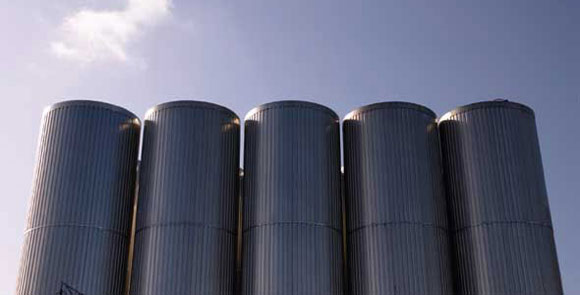
Fortified Islands is the scenario wherein security concerns are top of mind. This scenario is characterized by geopolitical unrest, a lack of international cooperation and trust, and protectionist government policies.
Scenario Overview (2005-2030)
Global Forces
At the beginning of the Fortified Islands Scenario, geopolitical tensions around the world threaten energy supply. This raises concerns about energy security in major energy-consuming regions that see energy resources increasingly becoming concentrated outside of their borders and their sphere of control. Increased security risks add a premium to fuel costs and by 2010, energy prices are at near record highs.
Despite these higher energy prices, adequate investment in global energy supplies and infrastructure do not take place, as political relations around the world continue to become more tenuous and access to energy resources and the capital to develop them becomes increasingly more difficult. Unlike in the Triple E Scenario, international cooperation is not seen as a viable option to deal with supply shortages and countries turn inwards or toward 'friendly' trading partners to find solutions. Large energy-consuming nations focus on energy self-sufficiency, and the development of domestic energy resources are a top priority. Pockets of technological development occur to reduce energy demand and increase supplies of alternative resources. However, the lack of global cooperation hinders deployment across countries.
A lack of trust between nations leads to increased trade barriers and other roadblocks that restrict supply chains and reduce the benefits of trade. These factors take their toll: global energy markets remain tight, oil prices remain high and unpredictable, and global economic growth is restrained.
The social and environmental principles espoused under 'sustainable development' at the turn of the century are less prevalent by the end of the Fortified Islands Scenario. Instead, national defence and job creation are topical issues. Further, international agreements on major environmental issues such as climate change remain tenuous and non-binding. Instead, environmental issues are addressed locally and are more likely a co-benefit of energy demand management, rather than a result of dedicated programs to improve emissions.
By 2030, energy security trumps environmental concerns in this scenario and, therefore, significant investments in local energy options including coal take place. Countries are also more willing to develop higher cost unconventional resources even if this may mean environmental trade-offs. Energy demand is lower in Fortified Islands than in the other scenarios because of the slower economic growth rates and high world energy prices.
Canadian Outcomes
Despite Canada's abundant energy resources, Canadians are not immune to security concerns shaping the globe, although they are affected differently. The Fortified Islands Scenario has the slowest economic growth for Canada. The more protectionist policies of Canada's trading partners and the reduction in demand worldwide have resulted in relatively slow overall growth in Canada. The energy industry is the exception. Limited access to global resources ensures Canadian supplies are in high demand.
In this scenario, large energy importers are conscious of their uncertain situation and self-reliance is the central theme in their domestic energy policies. A different dynamic occurs in countries like Canada, where there is a dual policy focus of providing safe, secure and affordable access to domestic supply, while also meeting international demand, in particular U.S. demand, in an integrated North American market. Canada develops an 'energy complex' in this scenario including returning the Sarnia-Montreal pipeline to eastbound service, by which Quebec gains access to western Canadian crude oil supplies. These projects are undertaken to ensure value added from resource supplies are derived domestically.
Canada's energy demand in this scenario is low due to slow economic growth. Canada's technology focus is on increasing energy supply and distribution. There is no national consensus on demand management issues or programs; however, Canada's energy intensity maintains a gradual improving trend. This is mostly due to high energy prices and North America-wide efficiency standards for appliances and transportation equipment. Although Canada is not subject to the same energy security issues as many countries, energy standards on imported goods is indicative of the efficiency legislation in place elsewhere.
Macroeconomic Outlook
Slow global economic growth and tight, unpredictable global energy markets shape the Canadian macroeconomic outlook in Fortified Islands. Population growth slows to 0.7 percent per year and labour force growth to 0.6 percent per year (Table 6.1). Productivity measured as output per employee is 1.2 percent per year. Slower export demand means less need to increase participation rates, keeping labour force growth low. It also means fewer resources for investment in capital, resulting in productivity levels lower than the other scenarios.
Table 6.1
Key Macroeconomic Variables – Fortified Islands, 2004-2030
| 1990-2004 | 2004-2030 | |
|---|---|---|
| Population | 1.0 | 0.7 |
| Labour force | 1.3 | 0.6 |
| Productivity | 1.4 | 1.2 |
| Gross domestic product | 2.8 | 1.8 |
| Goods | 2.5 | 1.7 |
| Service | 3.0 | 1.9 |
| Real disposable income | 3.6 | 3.9 |
| Exchange rate (average cents US/Cdn dollar) | 74 | 103 |
| Inflation rate (average %) | 2.3 | 1.8 |
| (Annual Average Growth Rate (% per year) unless otherwise specified). | ||
These combined factors lead to the slowest gross domestic product (GDP) growth of the three scenarios, averaging 1.8 percent per year.
In Fortified Islands there is a shift in the structure of the economy. The goods and services sector share drops as resources take a larger share of the economic base. The regional distribution of Canadian economic growth in Fortified Islands also evolves. Western Canada expands at the expense of eastern Canada. Alberta, British Columbia and the Territories experience economic growth above the national average (Figure 6.1). Ontario's economic growth slips below the national average in this scenario. It is interesting to note that the higher oil and gas industry growth in Saskatchewan, Newfoundland and Labrador and Nova Scotia means the relative contribution of these economies to overall Canadian GDP increases, but it is not strong enough to offset the loss of manufacturing growth, and as a result, these areas experience slower economic growth than in the other scenarios.
Figure 6.1
Real GDP Growth Rates – Fortified Islands 2004-2030
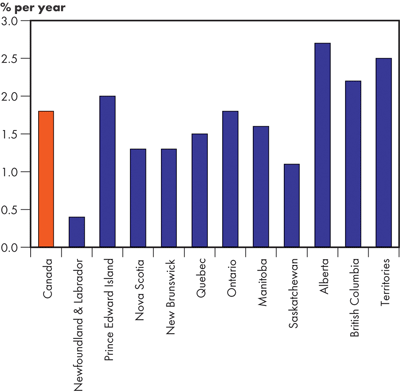
Energy Prices
Crude Oil Prices
Significant uncertainty in the global oil and gas industries leads to high and volatile crude oil prices[72]. The Fortified Islands Scenario reflects restricted access to global oil supplies due to high security concerns and unacceptably high risks in making major international investments. Countries place more emphasis on developing domestic energy sources, including unconventional sources, and seek additional supply from regional trading partners.
[72] The tools employed by the NEB for energy demand and supply modeling are based on annual historic data and forecasts annual series. In these types of models, the day-to-day volatility of oil and gas price markets can be masked. However, the NEB has taken a number of steps to ensure price volatility is considered within our analysis. Past decisions that consumers have made in the face of price volatility are captured in the estimated historic relationships and forecasted into the future. In addition, the NEB has modeled price variation within each of the scenarios and across scenarios. For example, within the Fortified Islands Scenario, oil prices increase from US$75 to US$85/barrel and gas prices range from US$7.50 to US$12/MMBtu. Across scenarios, oil prices range from US$35 to US$85/barrel and gas prices range from US$5.50 to US$12/MMBtu. The price trajectories that are modeled are consistent with market pressures inherent in each scenario, such as the availability of supply and the level of demand.
Crude oil prices in Fortified Islands increase to US$85/barrel rather than decline as in the other scenarios (Figure 6.2). They reach near record levels by 2010 and remain at this high level until the end of the period.
Figure 6.2
West Texas Intermediate Crude Oil Price at Cushing, Oklahoma – Fortified Islands
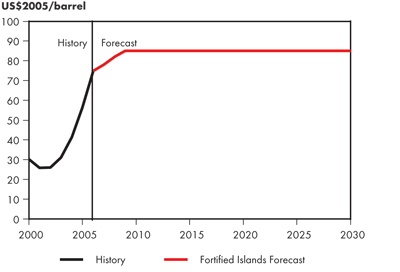
Natural Gas Prices
North American natural gas prices are assumed to generally track oil prices as they have historically. Security concerns and lack of international investment in the Fortified Islands Scenario severely limit liquefied natural gas (LNG) imports and put increased emphasis on higher-cost domestic gas supplies. Under these conditions, the Henry Hub natural gas price is US$11.40/GJ (US$12.00/MMBtu) (Figure 6.3). This represents a continuation of the typical price relationship with natural gas at 85 percent of the crude oil price.
Figure 6.3
Natural Gas Price at Henry Hub, Louisiana – Fortified Islands
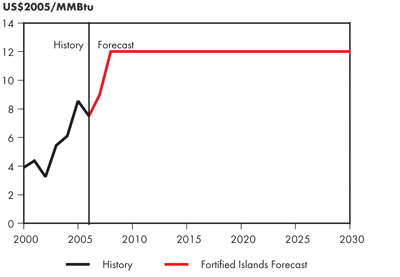
Electricity Prices
In Fortified Islands, pressure on electricity prices increases as oil and natural gas prices escalate from the levels of the early 2000s (to $85 oil, $12 gas) putting upward pressure on the costs for fossil-fired generation. To some extent, price pressure is mitigated by declining demand for new power generation and the security of heritage hydro assets, but the overall trend is upward[73].
[73] Regional electricity prices are provided in Appendix 5.
Coal Prices
Coal prices rise significantly from recent levels reflecting the sustained higher oil and gas prices in Fortified Islands ($85 oil and $12 gas), as well as the higher costs of exploiting new coal resources. Coal has a clear price advantage relative to its competitors in this scenario.
Energy Demand
Total Secondary Energy Demand Trends
Canadian total secondary energy demand in the Fortified Islands Scenario grows at a rate of 0.7 percent over the 2004 to 2030 period, significantly lower than the historical rate of 1.8 percent. The sectoral shares of demand do not change drastically over the forecast period. Oil and gas industries show strong growth, but total industrial sector energy demand growth is mitigated by the slowdown in non-energy industries as a result of higher energy prices and slower export demand for manufactured goods.
Demand sector shares and growth rates vary significantly by province. The three largest energy consumers are Alberta, Ontario and Quebec. In 2030, Alberta accounts for 35 percent of total secondary energy demand in Canada, Ontario accounts for 27 percent and Quebec 16 percent. Provincial population, personal disposable income and economic activity assumptions all affect provincial energy demand. Alberta and the northern territories show total secondary energy demand growth rates higher than the Canadian average. While most of the national economy suffers from high energy prices, an all-out expansion of western oil and gas plays drives economies of resource-rich provinces.
Figure 6.4
Canadian Total Secondary Energy Demand by Fuel – Fortified Islands

('Other' includes coal, coke, coke oven gas, and steam)
Overall Canadian demand intensity declines at 1.1 percent per year in the Fortified Islands, close to the historical rate of 1.0 percent from 1990 to 2004 (Figure 6.5). Higher energy prices induce a large uptake in energy efficiency measures, in particular, the low-cost measures that make the most of existing equipment and each unit of energy.
Figure 6.5
Canadian Total Secondary Energy Demand Intensity – Fortified Islands
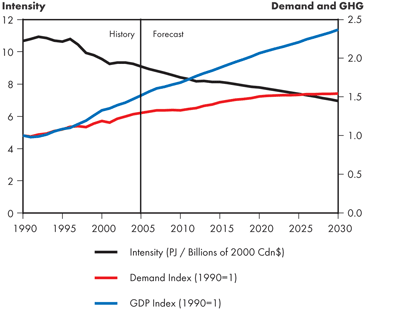
Residential Secondary Energy Demand
Canadian residential secondary energy demand grows at a rate of 0.5 percent over the 2004 to 2030 period (Figure 6.6). This is due to energy prices, economic constraints and efficiency improvements. Efficiency measures include low-cost retrofits such as compact fluorescent light bulbs (CFLs) and draft-proofing homes. There is some fuel-switching from oil, corresponding to an increase in biomass (wood) fuel. Fuel shares by province vary significantly.
Figure 6.6
Canadian Residential Secondary Energy Demand by Fuel – Fortified Islands
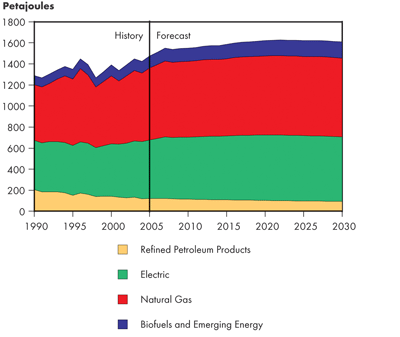
Commercial Secondary Energy Demand
Canadian commercial secondary energy demand grows at a rate of 0.5 percent per year over the 2004 to 2030 period, a significant decrease from the historical growth rate (Figure 6.7). Many low-cost efficiency upgrades (i.e., the use of blinds in commercial windows) are implemented; however, the Fortified Islands Scenario lacks the long-term financial and social will-power needed for investment in state-of-the-art building technology. The demand shares by fuel for Canada from 2004 to 2030 indicate some fuel-switching in the commercial sector from natural gas to oil. Fuel shares by province follow the same overall levels as the residential sector, with more oil use and almost zero alternative or emerging energy use.
Figure 6.7
Canadian Commercial Secondary Energy Demand by Fuel – Fortified Islands
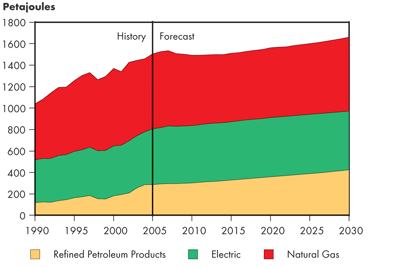
Industrial Secondary Energy Demand
Canadian industrial secondary energy demand grows at 0.9 percent per year over the 2004 to 2030 period, half the historical rate (Figure 6.8). Almost all industries demonstrate a slowdown in output and a corresponding decrease in energy demand. The exception is seen in the oil and gas industries, which expand as fast as possible to reap the benefits of high energy prices. The demand shares by fuel for Canada from 2004 to 2030 indicate fuel-switching into oil from all other fuels, including a share decrease in renewables as a result of slower pulp and paper industry economic growth.
Figure 6.8
Canadian Industrial Secondary Energy Demand by Fuel – Fortified Islands
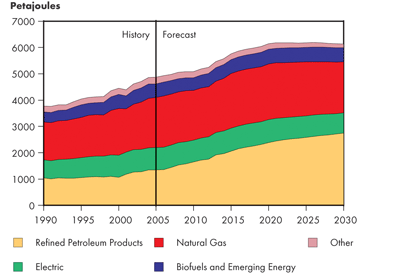
('Other' fuel includes coal, coke, coke oven gas, steam, naphtha)
In 2030, the largest provincial energy consumers are Alberta, accounting for 50 percent of industrial energy demand in Canada, Ontario with 20 percent and Quebec following at 13 percent.
Transportation Energy Demand
Canadian transportation energy demand grows at 0.7 percent over the 2004 to 2030 period (Figure 6.9). Costs are sufficiently high to induce a price response, particularly in passenger transportation where options such as mass transit and trading to a smaller, fuel-efficient vehicle becomes widespread. The demand shares by fuel for Canada over the forecast illustrate a drop in gasoline demand shares as price response and efficiency measures take place. The renewables share rises from zero to one percent by 2030, due to the assumed ethanol policies in Ontario and Saskatchewan[74], while the off-road share remains strong over the forecast given strong growth in the oil sands industry (Figure 6.10).
[74] The Ontario assumption is 5 percent ethanol volume (3.4 percent energy) of total gasoline use in the province by 2007. The Saskatchewan assumption is 7.5 percent ethanol volume (5.1 percent energy) of total gasoline use in the province by 2007.
Figure 6.9
Canadian Transportation Energy Demand by Fuel – Fortified Islands
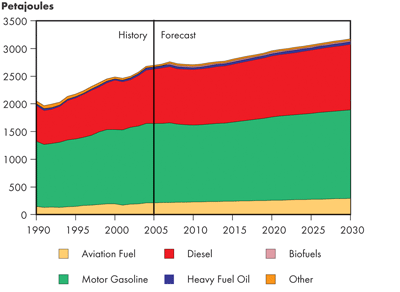
Figure 6.10
Canadian Transportation Energy Demand by Mode – Fortified Islands
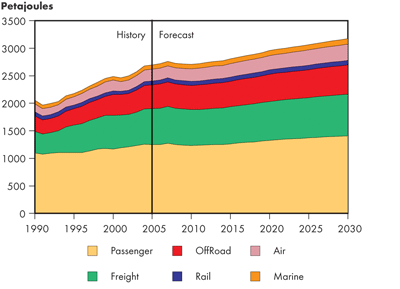
Oil Supply
Crude Oil and Equivalent
The Fortified Islands Scenario, with its focus on higher oil prices and support for domestic energy supply, is the most conducive to expanding oil supply. Compared to the other scenarios, decline trends in conventional supply in the Western Canada Sedimentary Basin (WCSB) are moderated from historical levels, while declines in eastern Canadian production levels are softened as well. The higher oil prices of the Fortified Islands Scenario are also the most supportive of oil sands expansion.
Crude Oil and Bitumen Resources
Canadian crude oil and bitumen resources are the same in the Reference Case and all three scenarios[75].
[75] Canadian crude oil and bitumen resources are set out in Chapter 3, and in further detail in Appendix 3.
Total Canada Oil Production
The Fortified Islands Scenario features the most aggressive production track, with an average increment of 27 000m³/d (170 thousand b/d) of capacity per year between 2010 and 2020, supported by rapid growth in oil sands production and new discoveries on the east coast offshore (Figure 6.11). Growth slows after 2020, under the effect of declining production in the east coast offshore and in the WCSB, with production reaching 879 000 m³/d (5.54 million b/d) by 2030.
Figure 6.11
Total Canada Oil Production – Fortified Islands
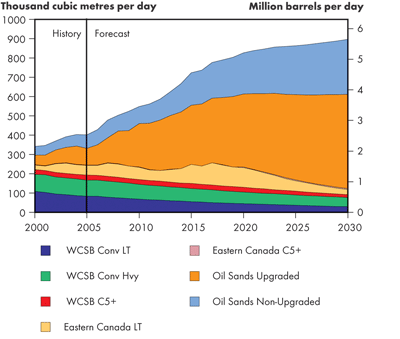
Oil sands production plays an increasingly important role, accounting for 88 percent of total Canadian oil production by 2030.
Conventional Crude Oil – WCSB
This scenario is the most favourable for an expansion in oil supply, with aggressive exploration drilling, more infill drilling and greater emphasis on improved recovery methods.
For conventional light crude oil, the long-term declining trend of five percent is reduced to 4.2 percent, with an additional 35 million cubic metres of production added above levels assumed for the Continuing Trends Scenario.
Alberta and Saskatchewan are the primary sources of conventional heavy crude oil, with British Columbia contributing minor amounts. Similar to light oil, the long-term declining trend of three percent is softened to 2.1 percent, with 51 million cubic metres of production added above levels described in the Continuing Trends Scenario (Figure 6.12).
Figure 6.12
WCSB Conventional Oil Production – Fortified Islands

Conventional light oil production declines to 29 500 m³/d (186 thousand b/d) and conventional heavy oil production declines to 48 100 m³/d (303 thousand b/d), by 2030. Condensate production levels decline to 14 000 m³/d (88 thousand b/d) in Fortified Islands.
Eastern Canada Light Crude Production
Projections for eastern Canada oil production are dominated by the east coast offshore, with only minor amounts of production expected from Ontario.
Higher prices in the Fortified Islands Scenario allow for a more aggressive expansion of east coast production, compared with the other scenarios. Similar to the Continuing Trends Scenario, Fortified Islands includes Hebron production commencing in 2013 along with contributions from smaller satellite pools in the Jeanne d'Arc Basin. It is assumed that a new 80 million m³ (500 million b) field is found in the relatively unexplored regions of the East Coast, potentially in the Flemish Pass region or in the Deepwater Scotian Shelf. The pool comes on-stream in 2015, bumping production levels to 75 000 m³/d (473 thousand b/d). In the Fortified Islands Scenario, a second similar sized pool comes on production in 2018 and allows for peak production of 118 000 m³/d (743 thousand b/d) in 2018, after which a relatively rapid decline begins. By 2030, production has declined to 26 700 m³/d (168 thousand b/d) (Figure 6.13).
Figure 6.13
Eastern Canada Light Crude Production – Fortified Islands
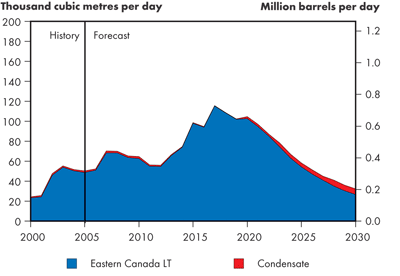
Oil Sands Supply
In the Fortified Islands Scenario, aggressive expansion is driven by high oil prices and supported by a lower cost of environmental compliance compared with the other scenarios. While cost pressures are assumed to moderate over time, the higher activity levels in this scenario will maintain these cost pressures at somewhat higher levels, relative to the other scenarios.
Fortified Islands also features rapid increases in production from thermal projects, primarily steam assisted gravity drainage (SAGD) and cyclic steam stimulation (CSS), with greater application of vapourized extraction (VAPEX) and toe-to-heel air injection (THAITM) than in the other scenarios.
Production reaches 774 000 m³/d (4.74 million b/d) in Fortified Islands. Upgraded bitumen volumes total 489 000 m³/d (3.08 million b/d) while non-upgraded volumes total 285 000 m³/d (1.80 million b/d) (Figure 6.14).
Figure 6.14
Canadian Oil Sands Production – Fortified Islands
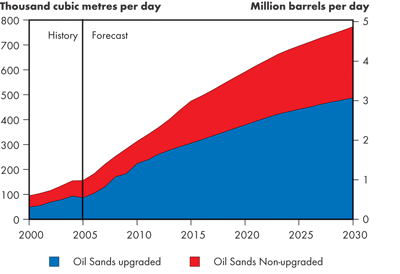
The Fortified Islands Scenario also includes 18 000 m³/d (113 thousand b/d) of oil sands production from Saskatchewan by 2030.
High natural gas prices in this scenario provide a significant economic incentive for oil sands operators to reduce their dependence on natural gas. An ongoing improvement in energy efficiency of one percent per year is assumed, while the pace of fuel-switching to alternative fuels is accelerated with respect to the other scenarios. In general, there is earlier and more prolific application of bitumen gasification, as well as increased application of multiphase superfine atomized residue (MSAR), THAITM, and VAPEX technologies, with potential for projects using geothermal energy as well.
In this scenario, the purchased natural gas intensity is reduced from 0.67 Mcf/b in 2005 to 0.49 Mcf/b in 2030, with total purchased natural gas requirements, excluding on-site electricity requirements, increasing from 18.4 million m³/d (0.65 Bcf/d) in 2005 to 62.3 million m³/d (2.2 Bcf/d) by 2030, in line with substantial oil sands production growth.
Supply and Demand Balances
This scenario is characterized by increasing supply and decreasing domestic demand. Although a new refinery added in the Atlantic region is also incorporated in Fortified Islands, there is little net effect on the supply and demand balance as the refined product produced at this refinery would be targeted to export markets such as the U.S. Northeast. The option of returning Enbridge Line 9 to eastbound service enabling Quebec refineries to obtain access to western Canadian crude oil is explored in this scenario[76]. The domestic demand for petroleum products in 2005 is 290 000 m³/d (1.8 million b/d) and increases to 352 000 m³/d (2.22 million b/d) in 2015. By 2030, demand is 415 000 m³/d (2.62 million b/d).
[76] Line 9 is a section on the Enbridge pipeline system that extends from Sarnia, Ontario to Montreal, Quebec. Originally, the crude oil flowed in the pipeline in a west-to-east direction. In 1999, the pipeline was reversed and began operations in an east-to-west direction, which enabled imports to reach the refining centres in Ontario.
Light Crude Oil - Supply and Demand Balance
Figure 6.15
Supply and Demand Balance, Light Crude Oil – Fortified Islands
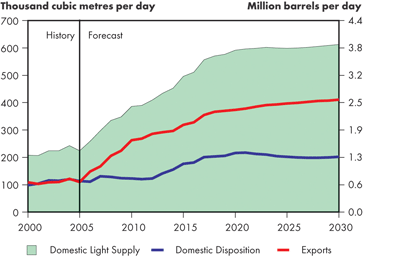
Exports of light crude oil increase sharply from 110 200 m³/d (694 thousand b/d) in 2005 to 319 700 m³/d (2.01 million b/d) in 2015 (Figure 6.15). This trend continues to 2030 with exports reaching 411 300 m³/d (2.59 million b/d).
Heavy Crude Oil - Supply and Demand Balance
Figure 6.16
Supply and Demand Balance, Heavy Crude Oil – Fortified Islands
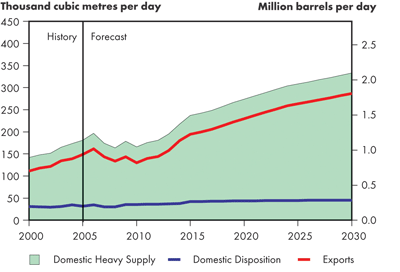
Exports of heavy crude oil increase from 149 200 m³/d (940 thousand b/d) in 2005 to 195 000 m³/d (1.23 million b/d) in 2015. By 2030, exports increase to 287 500 m³/d (1.81 million b/d) (Figure 6.16).
Natural Gas Supply
Canadian Natural Gas Resource Base
The higher prices of the Fortified Islands Scenario allow previously uneconomic volumes of unconventional resources to be included in the recoverable category. Western Canadian coalbed methane (CBM) remaining resources increase to 1 416 billion m³ (50 Tcf)[77]. Similarly, remaining tight gas and shale gas resources are raised to 737 and 365 billion m³ (26 and 12.9 Tcf), respectively. These increases reflect the estimated economic viability of additional unconventional deposits in settings with lower permeability and at greater depths. To access these additional resources, the higher gas price in Fortified Islands could accommodate the increased cost of wells with longer horizontal legs and more extensive hydraulic fracture stimulation.
[77] As indicated in Appendix 4.
Figure 6.17
Natural Gas Production Outlook – Fortified Islands

As with the Triple E Scenario, the estimate of the remaining conventional resource base is unchanged. The estimate of the remaining conventional resource base is defined by the minimum reservoir size for each play type that is considered technically feasible for the industry to develop. Within the price range considered, the minimum reservoir sizes adopted in the resource estimate for the Reference Case and Continuing Trends Scenario are also applicable to the Triple E and Fortified Islands Scenarios. However, the higher price environment in the Fortified Islands is better able to accommodate higher annual levels of gas drilling and the corresponding escalation of costs.
For similar reasons, the remaining resource base for frontier projects is also unchanged for this scenario. The frontier resource estimate from the Reference Case and Continuing Trends Scenario incorporates the NEB's best current estimate of technically recoverable marketable gas and is applicable to the range of prices considered. The high cost and risk to establish basin-opening infrastructure makes it likely that facilities will be sized at a conservative level initially and then gradually expanded as the productivity of the resource is confirmed. Until such confirmation is available through more extensive drilling and some production history, an upward adjustment to the resource base can not be made with any confidence.
Production and LNG Imports
In this scenario, LNG supply to North America is dramatically curtailed and natural gas markets are reliant on continental supplies. Liquefied natural gas imports might be curtailed by a shortage of new liquefaction facilities due to an unstable foreign investment climate, or by extreme LNG demand growth outside North America, or some combination of the two. Except for a brief period from 2009 to 2014 when LNG imports into Canada average 14 million m³/d (0.5 Bcf/d), LNG serves markets with little to no indigenous natural gas supply including Japan, Korea, India and western and southern Europe, instead of North America. Liquefied natural gas has no influence on North American natural gas prices, which are able to move upward and support the costs of high drilling activity, major frontier projects and higher-cost conventional and unconventional gas developments in Western Canada.
Natural gas drilling in Western Canada is projected to gradually increase after 2007 to average roughly 24 000 wells per year. This level of activity could be in the range of about 1 075 drilling rigs operating at an average annual utilization of 55 percent[78].
[78] The recent gas drilling peak in 2005 was 18,300 wells from 700 drilling rigs, averaging 59 percent utilization. The size of the 2007 Western Canada rig fleet is roughly 880 rigs (NEB, Canadian Association of Oilwell Drilling Contractors [CAODC]).
At this high rate of drilling, Western Canada natural gas production could be maintained at between 467 and 484 million m³/d (16.5 and 17.1 Bcf/d) from 2011 to 2020, as shown in Figure 6.17. After 2020, conventional gas production begins to decline gradually as drilling fails to keep up with ongoing reductions in new well productivity.
The increase in the unconventional gas resource base and higher activity allows unconventional gas production to rise steadily, outpacing conventional gas output by 2028. Coalbed methane production reaches 57 million m³/d (2.0 Bcf/d) in 2014 and stabilizes at 99 million m³/d (3.5 Bcf/d) from 2020 to 2030. From 2016 onward, Mannville Formation CBM overtakes output from the Horseshoe Canyon Formation and CBM represents slightly more than half of the unconventional production. Tight gas production peaks in 2015 and then enters a shallow decline, while shale gas production grows steadily to reach almost 54 million m³/d (1.9 Bcf/d) by the end of the period.
While Western Canada is able to hold production fairly flat to 2020, it is the contribution from frontier projects from 2015 onward that accounts for significant growth in Canadian natural gas production. Subject to regulatory reviews and subsequent commercial decisions, Mackenzie Delta production is assumed to begin in late 2014 and expand to 68 million m³/d (2.4 Bcf/d) by 2025. Production of the gas associated with oil projects on Newfoundland's Grand Banks is assumed to begin two years earlier in 2015 and subsequently double its scale to 28 million m³/d (1 Bcf/d). Other conceptual frontier projects could potentially be economically viable sources of supply in Fortified Islands, including development of the 1970s-era gas discovery on Melville Island in the western Arctic, the possibility of a Nova Scotia deepwater discovery and development of discoveries offshore Labrador.
Supply and Demand Balance
Until 2015, Canadian natural gas supply remains relatively flat while gas demand increases moderately. Relative to 2005, this results in a tightening of the differential between Canadian natural gas supply and demand by an average of 20 million m³/d (0.7 Bcf/d) through 2014, as shown in Figure 6.18. From 2015 onward, strong growth in Canadian gas supply far exceeds demand growth that is being slowed by higher prices. As a result, from 2015 to 2030 the differential widens by an average of 45 million m³/d (1.6 Bcf/d) above 2005 levels.
Figure 6.18
Supply and Demand Balance, Natural Gas – Fortified Islands

In Fortified Islands, Canadian gas demand growth is slowed by higher energy prices and lower economic growth. An exception is seen in increased gas demand for oil sands due to significantly higher oil output. Gas intensity for oil sands is lowest in Fortified Islands, as higher gas prices create a greater incentive to employ alternative technologies. Relative to 2005, overall Canadian natural gas demand rises by roughly 16 percent over the period.
With the initial shrinkage in the differential, the net amount of natural gas available for export slips below the 2005 level until 2015. From 2015 onward, the average level of potential annual net exports is 303 million m³/d (10.7 Bcf/d), exceeding the previous peak of 297 million m³/d (10.5 Bcf/d) achieved in 2001.
Natural Gas Liquids
Supply and Disposition
In the Fortified Islands Scenario, large excess volumes of propane and butanes are available for export throughout the projection period, as this scenario has the highest conventional natural gas and oil sands off-gas production[79].
[79] Further detail on the propane and butane supply and demand balances can be found in Appendix 3.
Ethane Supply and Demand Balances
In Fortified Islands, supply exceeds demand through the entire projection period, with excess ethane of about 2 700 m³/d (17 thousand b/d) commencing in 2010, reaching a peak of about 17 000 m³/d (107 thousand b/d) in 2022 (Figure 6.19). The excess supply is caused mainly by higher supply of conventional ethane, as natural gas production is the highest under this scenario due to the rising price environment. In addition, increments of supply from oil sands off-gas, enhanced deep-cut straddle plant expansions and Mackenzie Delta gas are also the highest under this scenario.
Figure 6.19
Canadian Ethane Supply and Demand Balance – Fortified Islands
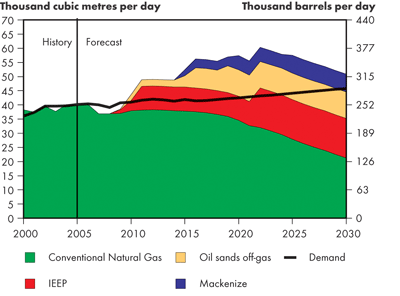
Electricity Supply
Capacity and Generation
In the Fortified Islands Scenario, the combination of higher energy prices and slower income growth causes a decline in demand for electricity after 2020. The impact of high energy prices is especially strong during the early years of the forecast period, when the greatest reduction in the growth of electricity demand occurs. Demand stabilizes once Canadians become accustomed to higher energy prices.
Generation capacity will increase by 32 percent between 2005 and 2030 in Fortified Islands (Figure 6.20). Capacity additions are intended to meet projected load requirements in a reliable, self-sustained manner. Electricity supply will primarily come from traditional generation sources, yet wind and other emerging technologies still experience strong growth.
Figure 6.20
Canadian Generating Capacity – Fortified Islands
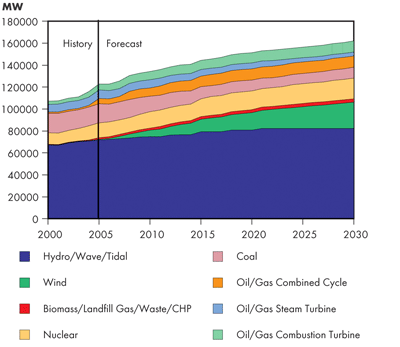
Hydro
In addition to the units listed in the Reference Case, after 2015 the following hydro facilities will be constructed: Peace River Site C (900 MW) in British Columbia and both Conawapa (1 380 MW) and Gull/Keeyask (600 MW) in Manitoba.
Hydroelectric generation will continue to provide about 60 percent of electricity needs throughout the forecast period (Figure 6.21). Hydro-based capacity will expand to 82 200 MW by 2030, an increase of 10 450 MW from 2006.
Figure 6.21
Canadian Generation – Fortified Islands
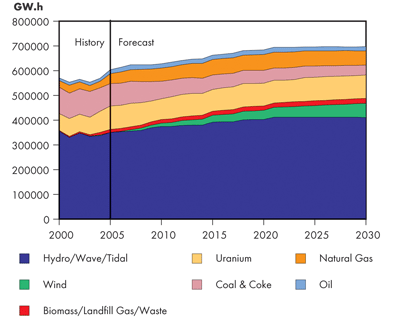
Nuclear Generation
While nuclear power has never lost favour in parts of Europe, in the last few years volatile fossil fuel prices, energy security concerns and increased focus on emissions have increased interest in nuclear power in North America. The last Canadian Deuterium (CANDU) reactor built in Canada was commissioned in 1993, but international sales have led to continual improvement in construction techniques and encouraged Atomic Energy Canada Limited to proceed with the design of the new Advanced CANDU Reactor (ACR). This design promises increased safety, quicker construction time and lower costs.
There are several applications for site licenses for new CANDU reactors before the Canadian Nuclear Safety Commission, which if approved, could lead to construction of new nuclear power plants inside a decade. All three scenarios include new nuclear facilities in Ontario and New Brunswick – provinces, which, like Quebec, have existing nuclear power plants.
While they have not been included in the scenarios of this study, there have also been proposals to use nuclear power instead of natural gas in the Alberta oil sands. Nuclear reactors are well suited to the 24/7 operation of oil sands facilities, promise independence from the price of natural gas and can be used to produce hydrogen for use in the upgrading of bitumen. Potential obstacles to the use of nuclear energy include the large size of a typical nuclear generator compared with a typical oil sands plant, the oil sands producers’ lack of experience with the technology, and public concerns about safety and the disposal of nuclear waste.
While use of nuclear energy in the oil sands poses certain challenges (as discussed in Alternative Fuels for Oil Sands text box earlier in this report), certain conditions may make this option less of a challenge. As ACR or other reactor technology matures, and if oil sands producers see a long-term, upward trend in natural gas prices, nuclear energy could look increasingly attractive. Concerns about minimizing greenhouse gas (GHG) emissions would also favour the use of nuclear energy. If an entity with nuclear experience were willing to build and operate such a plant, selling steam to oil sands producers and electricity to the Alberta market, nuclear energy could prove to be a viable option.
For further information on the use of nuclear energy in the oil sands, please refer to the Board’s Energy Market Assessments: Canada’s Oil Sands: Opportunities and Challenges to 2015 - May 2004 and Canada’s Oil Sands - Opportunities and Challenges to 2015: An Update - June 2006, found on the Board’s website at www.neb-one.gc.ca.
Nuclear
Total nuclear capacity increases 42 percent between 2005 and 2030, an increase of 5 500 MW from 2005. Assumptions regarding nuclear capacity are the same as in the Continuing Trends and Triple E Scenarios.
Natural gas-fired
The volume of gas-fired generation is similar to that of the Continuing Trends Scenario, with slightly less combined-cycle technology employed, but more combustion turbine/cogeneration units are constructed. As a result of higher gas prices and lower electricity demand, natural gas-fired generation is not called upon as often. Though natural gas-fired generation output accounted for 12 percent of 2030 electricity generation in the Continuing Trends Scenario, it accounts for eight percent in Fortified Islands.
Coal-fired
An assured supply of fuel and lower fuel cost provides the impetus for the construction of new coal-fired generation facilities in the Fortified Islands Scenario, but there is serious competition from oil sands associated cogeneration. Also, lower demand leads to a decline in installed capacity compared to the Continuing Trends Scenario, as not all existing coal-fired generation is replaced when it reaches the end of its operational life.
Oil-fired
Despite lower electricity demand and reduced generation from conventional oil-fired generation, in 2030 oil generation is about 15 percent higher in the Fortified Islands Scenario compared to Continuing Trends. This is due to bitumen-fuelled cogeneration associated with oil sands electricity and heat requirements. In 2020, retiring oil-fired generation in Newfoundland is replaced with a 180 MW natural gas-fired combined-cycle generation.
Emerging Technologies
High energy prices drive an increase in installed wind generation comparable to the Continuing Trends Scenario, despite lower demand for electricity. Wind power capacity is projected to reach 23 900 MW by 2030, representing 15 percent of total Canadian generation. Other alternative generation sources grow by 1 500 MW, or 89 percent. This illustrates that even in Fortified Islands, emerging technologies have a presence.
Exports, Imports and Interprovincial Transfers
Canadian net exports increase by 300 percent from 2006 to 112 100 GW.h in 2030 (Figure 6.22). This dramatic increase is due in large part to high electricity prices curtailing demand, combined with availability of hydro and other alternative sources of generation that are not subject to the higher price of fossil fuels in Fortified Islands. The increase in interprovincial electricity transfers (by 26 percent to 76 600 GW.h in 2030) is much less marked, but still substantial.
Figure 6.22
Interprovincial Transfers and Net Exports – Fortified Islands
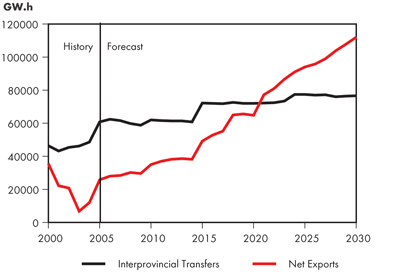
Coal
Supply and Demand
In Fortified Islands, isolationist policies slow economic growth and moderate demand for coal. As a result, production is lower than in Continuing Trends, but more than in Triple E. Energy security concerns encourage new coal-fired generation, most likely to be sited in Western Canada and the Maritimes. Demand for metallurgical coal decreases significantly in the Fortified Islands Scenario. Canadian coal production decreases to 47 Mt in 2030 from 55 Mt in 2015 because of the decrease in domestic demand of both thermal and metallurgical coal. Canada continues to be a net exporter in Fortified Islands. Canada's coal demand between 2015 and 2030 is estimated to decrease from 34 Mt to 22 Mt. Electricity generation will consume about 27 Mt in 2015, decreasing to 18 Mt by 2030. Canada's iron, steel and cement industries decrease by about 3 Mt of coal over this period with a substantial metallurgical coal decrease from 4 Mt to about 1 Mt. This could also result in a decrease in exports out of the iron, steel and cement manufacturing hubs in Ontario under Fortified Islands.
Exports of thermal coal remain low in Fortified Islands. Net exports remain consistent, at the same level as Triple E and Continuing Trends. Both thermal and metallurgical coal exports grow moderately by six percent between 2015 and 2030, due to slow economic growth in the U.S. and the lack of international cooperation. Between 2015 and 2030, there is a moderate increase of about four percent in thermal imports due to the addition of coal-fired units in the Maritimes, with metallurgical imports down roughly 78 percent due largely to the lack of competitiveness of the Canadian iron and steel industry.
Greenhouse Gas Emissions
Canadian total GHG emissions in Fortified Islands grow at a rate of 0.6 percent per year over the 2004 to 2030 period (Figure 6.23). This is lower than the historical growth rate of 1.7 percent from 1990 to 2004, largely due to the lower GDP growth rates and higher commodity prices leading to lower energy demand. The sectoral shares of GHG change over the forecast. The industrial sector share increases from 41 percent to 50 percent due to oil and gas growth assumptions in this scenario.
Figure 6.23
Canadian Total GHG Emissions by Sector – Fortified Islands
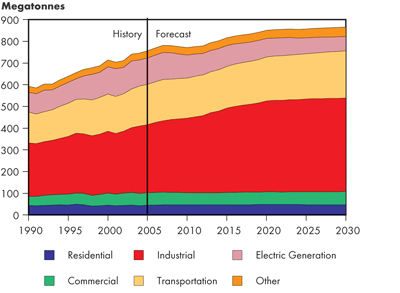
Greenhouse gas shares and growth rates vary by province. The three largest GHG emitters in 2030 are Alberta, Ontario and Quebec. Alberta accounted for 31 percent of total Canadian GHG emissions in 2004, and for 39 percent in 2030. Ontario's share drops from 27 to 22 percent over the outlook period, while Quebec's share hovers around 13 percent over the forecast.
Greenhouse gas levels do increase in Canada, but the GHG emissions intensity in Canada declines over the forecast. In Fortified Islands, the GHG emissions intensity declines at 1.3 percent per year, slightly faster than the historical rate of 1.1 percent per year as energy efficiency improvements take place and the share of alternative and emerging fuels increase (Figure 6.24).
Figure 6.24
Canadian Total GHG Intensity – Fortified Islands
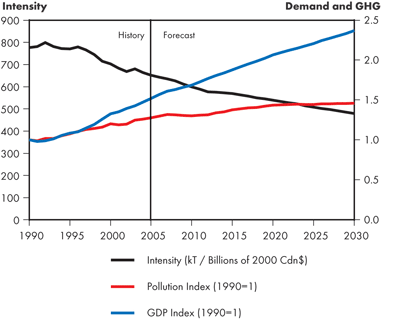
Fortified Islands Issues and Implications
- Overall, total Canadian economic growth is the lowest in this scenario and regional economic differences deepen. Stronger economic activity occurs in energy producing regions, whereas there is a slowdown in manufacturing regions.
- Energy demand in this scenario is dually impacted by higher energy prices and low income and economic growth. As a result, energy demand over the outlook period slows considerably from historic levels.
- Energy supply is exceptionally price dependent. This scenario represents a maximum plausible energy supply outlook for Canadian oil and gas.
- Fortified Islands features rapid expansion of oil sands development. It is assumed that oil sands operators will continue to make efficiency gains and employ alternative energy sources and recovery methods, with gasification of bitumen and petroleum coke playing a dominant role. As the scenario with the greatest available supply, exports of both light and heavy crude oil increase the most in this case.
- It is particularly interesting to note that maintaining current natural gas production levels requires very high prices. In this scenario, these high prices allow for Canada to continue to be a net exporter of natural gas, whereas in the other scenarios considered, Canada becomes a net importer of natural gas before the end of the outlook period. This is a result of the high prices bringing on additional supplies, such as mega-projects in remote locations in the north and off the East Coast. In addition, natural gas prices curb domestic natural gas demand growth.
- Finally, the slowdown in the energy demand growth rate translates into slowing GHG emissions growth rates compared to historic trends.
- The results are based on certain scenario assumptions. If these inputs do not materialize, then it puts at risk the outcomes described here. Specifically:
- For this scenario to occur, global relationships need to be under ongoing stress. Access to oil and gas supplies are constrained keeping energy prices high. These prices govern economic conditions as well as energy demand and supply trends.
- As well, to allow these types of energy supply expansions to take place technological advancements must occur; sufficient inputs into the production processes, such as labour, must be in place; and, infrastructure must be developed.
- Date modified:
